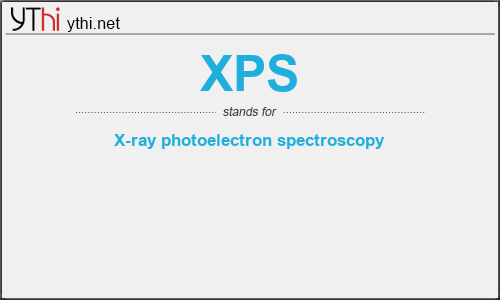What does XPS mean? What is the full form of XPS?
The Full Form of XPS is X-ray photoelectron spectroscopy.
X-ray photoelectron spectroscopy (XPS) is a quantitative technique for measuring the elemental composition of the surface of a material, and it also determines the binding states of the elements. XPS normally probes to a depth of 10 nm. However, because XPS is an ultra-high vacuum technique, the sample to be analysed has first to be evacuated. XPS has found extensive use in the investigation of textile surfaces, and this use is now spreading to the study of plasma-treated textiles. Plasma-treated textiles investigated by XPS include acrylics,10 polypropylene, wool and cotton.
XPS involves the detection of photoelectrons emitted from a sample as a result of irradiation of the sample by single-energy X-ray photons. XPS or electron spectroscopy for chemical analysis (ESCA) has become a relatively simple and increasingly routine technique for the compositional and chemical state analysis of surfaces. The basic principle of XPS is the photoelectric effect discovered by Hertz in 1887 [7, 8] and extended to surface analysis by K. Siegbahn and his research group at Uppsala University, Sweden, during the mid-1960s. Siegbahn won the Nobel Prize in Physics in 1981 for his work in XPS and coined the acronym ESCA [9]. Both XPS and ESCA are commonly used to describe this technique.
XPS is useful for quantitative analysis of surface composition and can detect all elements with the exception of hydrogen and helium through the detection of the binding energies of the photoelectrons. Small variations in binding energies of the photoelectron lines as well as Auger lines (see Section 16.5.1), satellite peaks, and multiple splitting can be used to identify chemical states. XPS is initiated by irradiating a sample with monoenergetic soft X-rays, most commonly Mg Kα (1253.6 eV with a line width ≈ 0.7 eV) or Al Kα (1486.6 eV with a line width ≈ 0.85 eV). In many modern instruments the Al Kα X-ray line is further narrowed (to ≈ 0.35 eV) using a monchrometer. Schematic representations of the photoemission and Auger processes are shown in Figures 16.3 and 16.4
XPS
means
X-ray photoelectron spectroscopy![]()
Translate X-ray photoelectron spectroscopy to other language.


Leave a Reply
You must be logged in to post a comment.